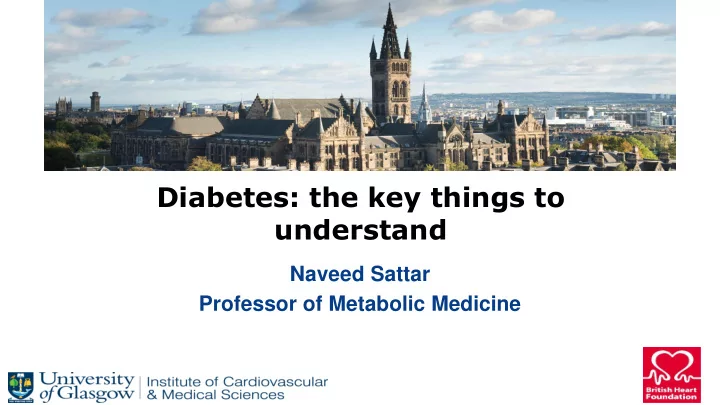

Diabetes: the key things to understand Naveed Sattar Professor of Metabolic Medicine
Duality of Interest Declaration Consultant or speaker for: Eli Lilly, Boehringer Ingelheim, Janssen, AstraZeneca, Novo Nordisk, Sanofi Grants: Boehringer Ingelheim
ERFC (2010) Lancet
44% 29% Rashwani et al (2017) NEJM
Heterogeneity in risks • By age of onset • T1 vs T2DM • When combined with prior CVD
8-12 years 3-6 yrs Sattar et al (2019) Circulation
Younger age of T1DM diagnosis associated with greater loss of life years (~16 years in those diagnosed <10 years, most 12 years) 16 years 10-12 yrs Rawshani et al (2018) Lancet
HF data Scotland-wide data T1>T2>No diabetes McAllister et al (2018) Circulation
Average presentations & risk paradigm in T1DM vs T2DM Hyperglycaemia T1DM dominant early on CV risk Risks higher before Diagnosis- obesity T2DM HBP, abn. Lipids etc Healthy Teenage 45-60 years years Age Sattar (unpublished)
Heterogeneity in risks • By age of onset • T1 vs T2DM • When combined with prior CVD
Background: diabetes plus CVD means very high risk premature mortality ERFC et al. JAMA 2015;314:52 – 60 .
No evidence from prospective trials that more intensive glycaemic control reduces mortality Meta-analysis including 27,049 participants and 2370 major vascular events Number of events (annual event rate, %) Hazard ratio ∆HbA1c (%) Trials More intensive Less intensive (95% CI) All-cause mortality ACCORD 257 (1.41) 203 (1.14) -1.01 Overall HR (95% CI) ADVANCE 498 (1.86) 533 (1.99) -0.72 1.04 (0.90, 1.20) UKPDS 123 (0.13) 53 (0.25) -0.66 VADT 102 (2.22) 95 (2.06) -1.16 Overall 980 884 -0.88 Cardiovascular death ACCORD 137 (0.79) 94 (0.56) -1.01 ADVANCE 253 (0.95) 289 (1.08) -0.72 UKPDS 71 (0.53) 29 (0.52) -0.66 VADT 38 (0.83) 29 (0.63) -1.16 Overall 497 441 -0.88 1.10 (0.84, 1.42) 0.5 1.0 2.0 Favours more Favours less 12 12 intensive intensive Turnbull FM et al. Diabetologia 2009;52:2288
New approaches to reducing blood glucose low hypo risks, weight neutral or loss GLP-1 agonists/analogues e.g. exenatide Stimulate insulin Incretins release Reduce • (GIP) blood glucose • GLP-1 Inhibit glucagon release DPP-4 Inhibit renal Breakdown re-absorption products DPP-4 inhibitors (SGLT2 inhibitors) (“gliptins”)
Diabetes to CVD pathways: more than atheroma Lipids Glucose Accelerated Traditional BP MI, CVA, PAD Atherogenesis focus Thrombotic tendency T2DM Insulin Na + & Renal SGLT2 Obesity Volume glucose Glomerular Heart retention Status/ Novel Failure hyperfiltration Intravascular Hemodynamic Insights TGF volume Kidney & Glomerular other mechanisms? increase stress disease Sattar N, McGuire D. Circulation (2018)
GLP-1R Agonist CV Outcome Trials favours GLP-1RA favours placebo 3-component MACE ELIXA Exendin-4 based EXSCEL HR 0.95 (0.86-1.06) LEADER Human GLP-1 SUSTAIN-6 based Harmony Outcomes Test for HR 0.82 (0.75-0.90) heterogeneity I 2 = 59% HR 0.88 (0.80-0.96) Overall p-value =0.044 0,5 1 2 Kristensen SL et al (2019) TLDE (+ PIONEER 6 overall 0.88 (0.82 to 0.94))
GLP-1R Agonist CV Outcome Trials: other outcomes ELIXA All cause ELIXA CV Mortality EXSCEL EXSCEL Mortality HR 0.91 (0.81-1.03) HR 0.88 (0.80-0.98) LEADER LEADER SUSTAIN-6 SUSTAIN-6 Harmony Harmony HR 0.85 (0.74-0.97) HR 0.90 (0.81-1.00) Overall HR 0.88 (0.80-0.96) Overall HR 0.89 (0.83-0.96) 0,5 1 2 0,5 1 2 ELIXA ELIXA Myocardial Stroke EXSCEL EXSCEL Infarction HR 0.99 (0.90-1.10) HR 0.93 (0.72-1.21) LEADER LEADER SUSTAIN-6 SUSTAIN-6 Harmony Harmony HR 0.81 (0.72-0.91) HR 0.84 (0.72-0.98) Overall HR 0.90 (0.80-1.00) Overall HR 0.87 (0.77-0.97) 0,5 1 2 0,5 1 2 Kristensen SL et al (2019) TLDE (+ PIONEER 6/REWIND)
GLP-1RA lessen HF Kristensen SL et al (2019) TLDE
Treatment algorithm in patients with T2DM and ASCVD or high/very high CV risk - drug naïve (1) ESC/EASD guideline 2019 a) Type 2 DM - Drug naïve patients - + ASCVD, or high / very high CV risk (target organ damage or multiple risk factors) a SGLT2 inhibitoror MetforminMonotherapy GLP-1 RAMonotherapy b If HbA 1c abovetarget If HbA 1c above target SGLT2i DPP-4i TZD GLP-1 RA if eGFR AddMetformin adequate If HbA 1c abovetarget
Diabetes top lines for cardiology • Diabetes doubles CVD risk beyond usual risk factors • Risks down: LLT, BP Rx. Less smoking – Intensive glucose lowering, benefits non-fatal CVD modestly • Lifetime risks higher when: – Younger onset T2 / T1DM / CVD & diabetes • CVOT: agent type matters more than glucose-lowering per se – CVD benefits from GLP-1RA and SGLT2i classes – Mechanisms and clinical implications?
Recommend
More recommend